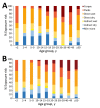Exposure-Specific and Age-Specific Attack Rates for Ebola Virus Disease in Ebola-Affected Households, Sierra Leone
- PMID: 27144428
- PMCID: PMC4982163
- DOI: 10.3201/eid2208.160163
Exposure-Specific and Age-Specific Attack Rates for Ebola Virus Disease in Ebola-Affected Households, Sierra Leone
Abstract
Using histories of household members of Ebola virus disease (EVD) survivors in Sierra Leone, we calculated risk of EVD by age and exposure level, adjusting for confounding and clustering, and estimated relative risks. Of 937 household members in 94 households, 448 (48%) had had EVD. Highly correlated with exposure, EVD risk ranged from 83% for touching a corpse to 8% for minimal contact and varied by age group: 43% for children <2 years of age; 30% for those 5-14 years of age; and >60% for adults >30 years of age. Compared with risk for persons 20-29 years of age, exposure-adjusted relative risks were lower for those 5-9 (0.70), 10-14 (0.64), and 15-19 (0.71) years of age but not for children <2 (0.92) or 2-4 (0.97) years of age. Lower risk for 5-19-year-olds, after adjustment for exposure, suggests decreased susceptibility in this group.
Keywords: Ebola; Ebola virus; Ebola virus disease; Sierra Leone; attack rates; cohort study; exposures; households; infectious disease transmission; risk factors; survivors; transmission; viruses.
Figures



References
MeSH terms
Grants and funding
LinkOut - more resources
Full Text Sources
Other Literature Sources
Medical

